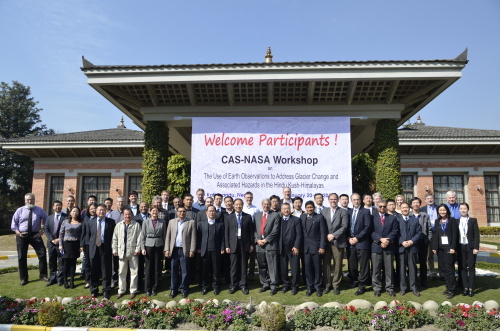The CAS-NASA “Workshop on the Use of Earth Observations to Address Glacier Change and Associated Hazards in the Hindu Kush Himalayas” was held from January 20 to 23 in Kathmandu, the capital of Nepal.
Against the background of the recent China-US Joint Announcement on Climate Change, the meeting was jointly sponsored by the Chinese Academy of Sciences (CAS) and the National Aeronautics and Space Administration (NASA), and co-organized by the CAS Institute of Remote Sensing and Digital Earth (RADI) and the Earth Science Division of NASA, with support from the International Centre for Integrated Mountain Development (ICIMOD).
Themed on the use of Earth observations to address glacier change and associated hazards in the Hindu Kush Himalayan (HKH) region, it pooled together more than 40 renowned Chinese and US experts and scholars in the field of glaciers and snow cover from a variety of institutions of the two countries.
CAS President BAI Chunli and NASA Administrator Charles F. Bolden sent their congratulatory letters. BAI said in his letter, “I am pleased to welcome experts from both the US and China to get together in Nepal to discuss glacier change and associated hazards, and to explore means of using Earth observations to further enhance our scientific understanding about the Hindu Kush Himalayas”. Bolden said, “I am delighted that U.S. and Chinese scientists will be exchanging information for the first time on Earth-observation products for glacier characterization.”
RADI Director-General GUO Huadong and Michael Freilich, Director of NASA Earth Sciences Division, delivered keynote speeches at the opening session. In his talk, GUO provided an overview of Earth observation for climate change in the HKH region, and gave a brief account of the application of international satellites, focusing on China’s satellites in particular. Freilich summarized in his talk key historical and ongoing NASA space-based measurements, as well as related research programs and modeling capacities in this region.
(Resource from Institute of Remote Sensing and Digital Earth, Chinese Academy of Sciences.)

A scene of the CAS-NASA workshop (picture by RADI)

Group photo(picture by RADI)
